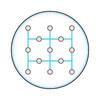Our program combines theory and experiment. Theory is extending the fundamental understanding of systems at the atomic/nanoscale interface, probing the frontier between the classical and the quantum, exploring new applications in nanoscale and quantum technologies, and motivating new, precision metrology. We are developing the theoretical understanding needed to exploit nanoplasmonic and semiconductor quantum dot structures for quantum and nanoscale technologies, to develop next generation atomic clocks, to simulate exotic condensed matter with ultracold atoms, to understand quantum information propagation in interacting systems, and to implement useful quantum information, detection and measurement protocols.
Experiment is being conducted to develop precision measurement tools for this regime, to collect precise data essential for the applications mentioned, and to further the understanding of these systems. We are probing the charge and spin transport, optical, and mechanical properties of nanoscale and quantum-coherent solid-state systems. We are exploiting nanoscale Si devices to provide precision charge sensing on-chip. We are exploring the use of these nanoscale Si devices for quantum technology and are pushing these devices to the atomic scale using structures fabricated by controlled placement of individual dopants. Such devices will allow us to explore the ultimate atomic-scale limit for traditional Si electronic devices and implement atomic-scale quantum technologies in Si. We are developing isotopically enriched Si needed for Si quantum technology and investigating novel materials for spintronics. We are developing semiconductor quantum dots as useful sources of single photons, entangled photons, and charge and spin qubits. We are creating nanomechanical devices whose mechanical vibration can approach the quantum ground state, opening the way to macroscopic quantum systems.
News and Updates
Projects and Programs
Publications
Awards
Contacts
Group Leader
-
(301) 975-2595
Group Office Manager
-
(301) 975-8376










